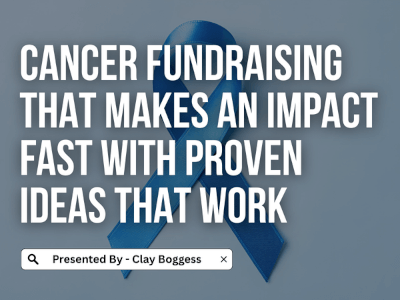
The ultimate guide to peer-to-peer fundraising for schools.
Most schools spend much time and effort on fundraising—whether for an extracurricular activity, a specific program, or the school. Even though this school year looks much different than previous ones, the need for sufficient funding remains the same.
We suggest a peer-to-peer fundraising campaign if you’re looking for a good school fundraiser to host this year.
Fundly has worked with several schools and other fundraising organizations, so they know about pulling off a successful campaign. Specifically, if your goal is to host a peer-to-peer fundraiser that will make a real difference, there are certain things you must do.
Here are five steps that you can take that will transform your outcome and impact those around you:
- Choose the right peer-to-peer fundraising platform.
- Gather supporters to fundraise on your behalf.
- Set goals and launch your campaign.
- Track and encourage fundraisers.
- Wrap it up and thank donors.
With the sudden move to exclusively virtual fundraising strategies due to COVID-19, peer-to-peer fundraising campaigns are fantastic for garnering support across a large, geographically distributed support base. This is especially true thanks to the power of social media and other digital tools.
Are you ready to learn more about optimizing your peer-to-peer fundraising strategies? Let’s dive in!
1. Choose the right peer-to-peer fundraising platform.
Luckily for organizations like yours, there are a ton of excellent peer-to-peer fundraising platforms available for schools and fundraisers to choose from. But how do you know which one is the best?
According to Fundly’s guide to peer-to-peer fundraising platforms, you should be on the lookout for a fundraising tool with the following characteristics:
- Positive user experience: If the users (volunteer fundraisers and their donors) cannot navigate your platform in a simple and streamlined way, you’re likely to miss out on many potential gifts. Instead, ensure any user can quickly and easily donate in under a minute.
- Standout features: Look for features that go beyond the basic peer-to-peer functionality. For example, gamification tools like leaderboards and fundraising thermometers can help encourage your fundraisers to try their best by instilling a sense of friendly competition among students.
- Cost-effectiveness: You don’t want to blow your entire budget on a fundraising tool. Luckily, free and low-cost fundraising platforms are available for schools to use. However, keep an eye out for platform and payment processing fees.
- Integrations: When looking for any new software solution, it’s a good idea to look into any integrations they offer. For a school fundraising platform, useful integrations with CRM and volunteer management tools can make a huge difference in your overall operations. For example, parents will appreciate the convenience of raising money for their child’s campaign while also signing up to volunteer for a fundraising event all within the same platform.
Your peer-to-peer platform is essentially the foundation of your fundraiser and works to set your school up for success. That being said, it’s essential to research and find the right platform for your needs.
2. Gather supporters to fundraise on your behalf.
Volunteer fundraisers are the most essential part of any peer-to-peer fundraising campaign. In the case of a school campaign like yours, these fundraisers will likely be the students and parents.
That’s one of the reasons why schools love peer-to-peer campaigns so much—they already have built-in fundraisers willing and able to raise funds on their behalf. However, gathering these supporters and sending them off unprepared is insufficient.
You need to equip fundraisers with strategic peer-to-peer resources such as:
- A personal fundraising page: In a peer-to-peer fundraiser, each volunteer fundraiser should have a personalized fundraising page to which their supporters will give. Although the funds all end up in the same place (your overall fundraising account), a student’s friends and family members will be more likely to contribute to an individual donation page than your general school fundraising page. Because even if they don’t feel a significant connection to your school, they do to the student—so that should be the central focus.
- Donation outreach templates: Since your fundraisers will be requesting donations on your behalf, providing them with several customizable templates is a good idea. Popular ones include social media posts, emails, and text messages. Plus, you can provide fundraisers with examples of how they can personalize their fundraising page to encourage their networks of support to contribute.
While some students may opt out of your peer-to-peer fundraising campaign, more than likely, you’ll have a good number of students and parents who are excited to participate. And when you provide fundraisers with adequate resources like these, more students will be confident in helping.
3. Set goals and launch your campaign.
It’s almost time to start fundraising! But first, you’ll need to set your fundraising goals and get volunteer fundraisers ready to begin.
Here are a few best practices to consider at this point in the peer-to-peer fundraiser planning process:
- Set individual fundraising goals. Each student should have an individual fundraising goal to motivate their fundraising efforts. You can determine this individual goal by dividing your overall school fundraising goal by the number of students participating. However, not all students will follow through and may fall short, so adjust your goals accordingly.
- Offer powerful fundraising incentives. Be sure to determine a set of unique and enticing fundraising incentives before beginning your campaign. This way, students know what’s at stake and may decide to participate even if they’re not thrilled about the fundraising. Studies show that fundraising incentives are known to boost donations and motivate students to raise more as compared to incentive-free fundraisers.
Determine your fundraising period. Be sure to set the start and end dates of your fundraiser strategically. Some fundraising experts claim that the best time to host a school fundraiser is from the end of August to the beginning of October. However, it’s possible to plan a successful fundraiser at any time—as long as you have top-notch resources.
Once you’ve completed these tasks, you should be ready to launch your campaign and begin bringing in funds for your school. This advanced preparation will help schools like yours focus on marketing and other critical aspects during the campaign.
4. Track and encourage fundraisers.
You’ve successfully started your campaign, and your students have begun fundraising for your school—what now?
Peer-to-peer fundraising best practices like these suggest you utilize gamification strategies throughout the campaign to continue engaging with your fundraisers. For example, you might set up a fundraising leaderboard (either online or in-person at your school) to showcase top fundraisers and encourage stragglers to improve their efforts.
Offer targeted support for individuals who either haven’t started fundraising yet or are struggling to bring in donations.
You can even provide these fundraisers with additional outreach templates or fundraising advice. Sometimes that extra boost can make a big difference!
5. Wrap it up and thank donors.
Now your peer-to-peer fundraising campaign has come to a close. However, your job is not done quite yet. It’s time to thank everyone who participated in your campaign as fundraisers and donors.
According to this DNL guide to virtual peer-to-peer fundraising, following up and thanking your fundraisers and supporters is crucial. However, how you do so may differ from your previous fundraising endeavors.
We suggest you follow up with donors at 2 key points in the engagement:
- Quickly following the initial gift: In a peer-to-peer fundraiser, you’ll likely receive gifts at various points throughout a several-month fundraising period. It’s a good idea to thank each donor as their gifts come in rather than wait until the end of the campaign to share your mass appreciation. Following up within 24-48 hours of receiving the initial gift ensures a more personalized donor experience.
- After the campaign has concluded: You might also want to thank your donors after your peer-to-peer fundraiser is over. In this scenario, you can convey your thanks on a grander scale while sharing critical statistics about the now-completed fundraiser. For example, if your school met your fundraising goal and brought in $X thousands of dollars, that’s a great thing to share with each supporter who made that possible. Updates like this convey your appreciation and give supporters an idea of how much of an impact they truly made.
More than likely, you received gifts from a plethora of new supporters. To effectively steward those budding relationships, they must be added to your constituent relationship management system (CRM). Even further, many CRMs come ready with automated donor acknowledgments that can also assist you in your follow-up communications.
Strategic online fundraisers like these have the potential to raise a ton of much-needed support for your school. However, you must be willing to invest the time and effort necessary to plan and pull off a successful peer-to-peer campaign.
Following the simple steps outlined in this guide, you can set your school up for an influential fundraiser that students, parents, faculty, and community members will love. Good luck!
Guest Author Bio
Lomesh Shah has over 25 years of experience in international corporate leadership with a strong emphasis on marketing technology and data management systems. Lomesh has worked with small to mid-size businesses, privately-held companies and Fortune 500 corporations in various capacities; from sales and marketing to overseeing automation and re-engineering of processes and operations.
As CEO of Fundly, Lomesh spends much of his time immersed in the nonprofit industry both as an industry leader, speaker, and in service to several organizations as a board member and volunteer. Outside of the industry, Lomesh is a technology junkie and will give anyone willing to listen an assessment of the latest trends in anything from espresso makers and mobile gadgets to electric cars and wind power.



